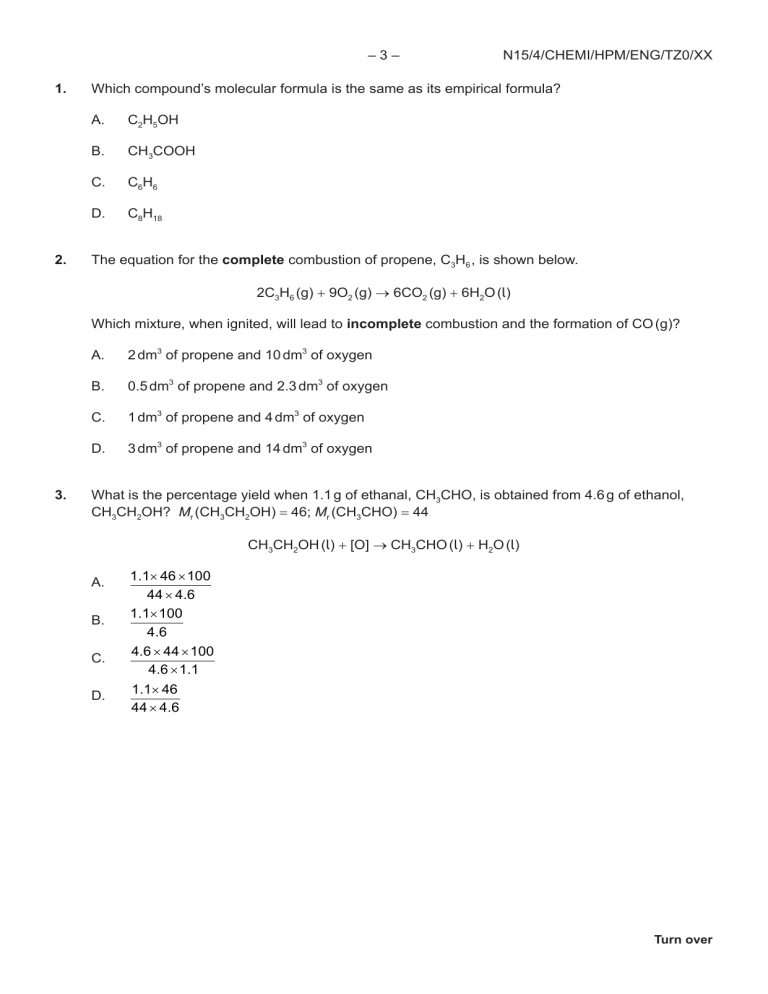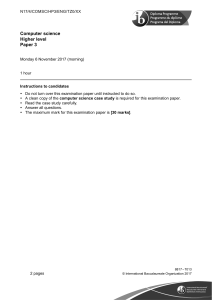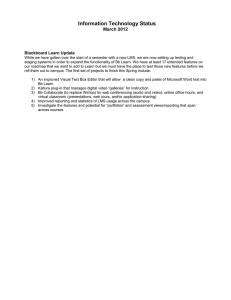
–3– 1. 2. N15/4/CHEMI/HPM/ENG/TZ0/XX Which compound’s molecular formula is the same as its empirical formula? A. C2H5OH B. CH3COOH C. C6H6 D. C8H18 The equation for the complete combustion of propene, C3H6 , is shown below. 2C3H6 (g) 9O2 (g) 6CO2 (g) 6H2O (l) Which mixture, when ignited, will lead to incomplete combustion and the formation of CO (g)? 3. A. 2 dm3 of propene and 10 dm3 of oxygen B. 0.5 dm3 of propene and 2.3 dm3 of oxygen C. 1 dm3 of propene and 4 dm3 of oxygen D. 3 dm3 of propene and 14 dm3 of oxygen What is the percentage yield when 1.1 g of ethanal, CH3CHO, is obtained from 4.6 g of ethanol, CH3CH2OH? Mr (CH3CH2OH) 46; Mr (CH3CHO) 44 CH3CH2OH (l) A. B. [O] CH3CHO (l) H2O (l) 1.1 46 100 44 4.6 1.1 100 4 .6 C. 4.6 44 100 4 .6 1 .1 D. 1.1 46 44 4.6 Turn over –4– 4. N15/4/CHEMI/HPM/ENG/TZ0/XX Which stage of operation immediately follows ionization in the mass spectrometer? A. Acceleration C. Detection D. Vaporization 5. the graph? First ionization energy / kJ mol–1 2000 1500 1000 500 3 4 5 6 7 8 9 10 Atomic number B. The graph increases from B to N because the atomic radius is increasing. C. The graph increases from Li to Ne because the number of electrons is increasing. –5– N15/4/CHEMI/HPM/ENG/TZ0/XX 6. 7. A. Al B. Ar C. Cl D. Cs Which elements are in the same group of the periodic table? B. Al, Ar, Cl, S C. Au, Hg, Pb, Pt D. As, Bi, P, Sb A. High melting point B. Variable oxidation number C. High density 8. 9. Which statement best describes the lattice structure of solid sodium chloride? 10. Which compound is most likely to contain ionic bonding? A. ClO2 B. CsCl C. SCl2 D. SiCl4 Turn over –6– 11. 12. 13. 14. N15/4/CHEMI/HPM/ENG/TZ0/XX Which molecule is polar? A. C2H6 B. CH2Cl2 C. CO2 D. CCl4 What is the shape of the hexacyanoferrate(III) ion, [Fe(CN)6]3 ? A. Square planar B. Hexagonal C. Octahedral D. Trigonal bipyramidal Which set contains two or more species with delocalized A. CH3CH3 , H2C CH2 , H2C O B. NaCl , C6H6 , H2C O C. CO32 , C6H6 , C6H12 D. O2 , CH3COCH3 , CH3COOCH3 electrons? Which of the following changes are exothermic? I. H2SO4 (aq) II. 2C8H18 (g) 17O2 (g) III. C8H18 (g) C8H18 (l) A. I and II only B. I and III only C. II and III only D. I, II and III 2NaOH (aq) Na2SO4 (aq) 16CO (g) 2H2O (l) 18H2O (g) –7– 15. N15/4/CHEMI/HPM/ENG/TZ0/XX Which change represents the standard enthalpy change of formation? A. The formation of 1 mol of a compound in its standard state from its gaseous atoms B. The formation of 1 mol of a compound in its standard state from its elements C. The formation of 1 mol of a compound in its standard state from its gaseous atoms in their standard states D. The formation of 1 mol of a compound in its standard state from its elements in their standard states A. C (g) + e B. Na (aq) e Na (s) C. 1 2 Cl2 (g) e Cl (g) D. B (g) 16. e C (g) B (g) + 2e 17. greatest magnitude of lattice enthalpy? Sum of ionic radii Ionic charges A. small large B. large large C. large small D. small small 18. lowest A. Solid at high temperature B. Solid at low temperature C. Gas at high temperature D. Gas at low temperature Turn over –8– N15/4/CHEMI/HPM/ENG/TZ0/XX Probability of molecules with kinetic energy E 19. I II Kinetic energy E the samples. the samples. –9– N15/4/CHEMI/HPM/ENG/TZ0/XX 20. labelled? y x 21. x-axis y-axis A. concentration time B. time concentration C. rate concentration D. concentration rate Which factors affect the rate constant, k, of a reaction? I. Catalyst II. Concentration of reactants III. Temperature A. I and II only B. I and III only C. II and III only D. I, II and III Turn over – 10 – 22. N15/4/CHEMI/HPM/ENG/TZ0/XX Which best describes a reaction in a state of equilibrium? and reactants are equal. concentrations of products and reactants are equal. and reactants are constant. concentrations of products and reactants are constant. 23. The equilibrium concentrations of X, Y, Z and W are 1, 2, 4 and 2 mol dm–3 X (g) 2Y (g) Z (g) W (g) Kc? 24. 25. A. 0.25 B. 0.5 C. 2 D. 4 Which of the following molecules can act as a Lewis acid but not as a Brønsted–Lowry acid? A. BF3 B. PCl3 C. NH3 D. H2 O Which is a 0.001 mol dm 3 solution of a weak acid? Conductivity pH A. poor 5 B. good 7 C. poor 10 D. good 3 – 11 – 26. N15/4/CHEMI/HPM/ENG/TZ0/XX What is the order of increasing acid strength? Approximate Ka and pKa Ka pKa ClCH2COOH 1 10 3 C6H5OH 10.0 CH3CH2COOH 1 10 5 C6H5NH3 4.6 A. ClCH2COOH < CH3CH2COOH < C6H5NH3 < C6H5OH B. C6H5OH < C6H5NH3 < ClCH2COOH < CH3CH2COOH C. C6H5OH < C6H5NH3 < CH3CH2COOH < ClCH2COOH D. C6H5OH < CH3CH2COOH < C6H5NH3 < ClCH2COOH A. HCl (aq) B. CH3CO2H (aq) CH CO2Na (aq) C. CH3CO2H (aq) NaOH (aq) D. CH3CO2H (aq) CH3CH2CO2H (aq) 27. NaCl (aq) 28. Salt Ionic radius of cation / 10–12 m A. CrCl3 63 B. FeCl2 76 C. MgCl2 65 D. NaCl 98 Turn over – 12 – N15/4/CHEMI/HPM/ENG/TZ0/XX 29. D 10 10 pH pH B 5 C 5 A 0 0 Volume of alkali added 30. Which element undergoes reduction in the following reaction? (NH4)2Cr2O7 (s) 31. Volume of alkali added A. Cr B. H C. N D. O N2 (g) 4H2O (l) Which best describes reduction? A. Increase in oxidation number and gain of electrons B. Increase in oxidation number and loss of electrons C. Decrease in oxidation number and gain of electrons D. Decrease in oxidation number and loss of electrons Cr2O3 (s) – 13 – 32. N15/4/CHEMI/HPM/ENG/TZ0/XX What is E À, in V, for the following reaction? VO2 (aq) 2H (aq) V2 (aq) 2V3 (aq) H2O (l) Standard electrode potential, E À / V V2 (aq) 2e V (s) 1.18 V3 (aq) e V2 (aq) 0.26 VO2 (aq) 2H (aq) e V3 (aq) VO2 (aq) 2H (aq) e VO2 (aq) A. 0.60 B. 0.08 C. 0.60 D. 1.26 H2O (l) H2O (l) 1.00 –3 33. electrolysed? 34. 0.34 A. Hydrogen B. Oxygen C. Sulfur D. Sulfur dioxide H2SO4 (aq) is Which pair of compounds can be distinguished by reacting them with dilute bromine water in the dark? A. CH3CH2COOH and CH3CH2CHO B. CH3CH2CHCHCH3 and CH3CH2CH2CH2CH3 C. CH3CH2CH(CH3)2 and CH3CH2CH2CH2CH3 D. CH3CH2CH2CHBrCH3 and CH3CH2CHBrCH2CH3 Turn over – 14 – 35. Which compound is most soluble in water? A. CH3CH2CHO B. CH3CH2CH2CHO C. CH3CH2CO2H D. CH3CH2CH2CO2H 36. I. II. III. 37. 38. Similar chemical properties Same general formula Differ by CH2 A. I and II only B. I and III only C. II and III only D. I, II and III Which formula represents propanenitrile? A. CH3CH2CN B. CH3CH2CH2CN C. CH3CH2CH2NH2 D. CH3CH(NH2)CH3 Which halogenoalkane reacts fastest with warm NaOH (aq)? A. (CH3)3CCl B. (CH3)3CBr C. CH3CH2CH2CH2Cl D. CH3CH2CH2CH2Br N15/4/CHEMI/HPM/ENG/TZ0/XX – 15 – 39. N15/4/CHEMI/HPM/ENG/TZ0/XX Which is the geometric isomer of cis H Cl A. B. C C Cl H H C C C C Cl Cl H Cl H H Cl C. Cl D. C C H H H H H C C Cl H C Cl 40. A. B. C. D. C H



